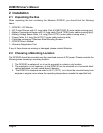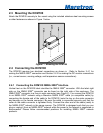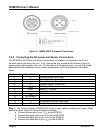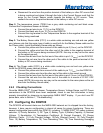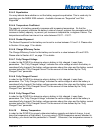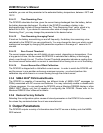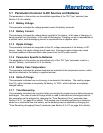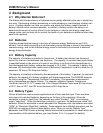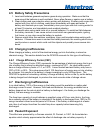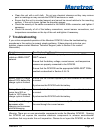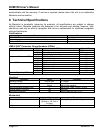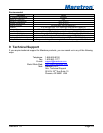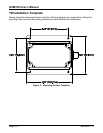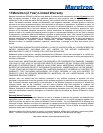
DCM100 User’s Manual
Page 10 Revision 1.0
4 Background
4.1 Why Monitor Batteries?
The lifetime and storage capacity of batteries can be greatly affected by the way in which they
are used. Discharging a battery excessively or under-charging or over-charging a battery can
ruin it. A battery monitor can help you monitor and adjust your battery usage to extend a
battery’s lifetime to the maximum possible. In addition, a battery monitor can help you to
determine the amount of energy stored in your batteries in order to plan energy usage and
charge cycles, and can help you to monitor the health of your batteries to determine when they
need to be replaced.
4.2 Batteries
A battery stores electrical energy in the form of chemical energy. Batteries are not 100%
efficient. Not all electrical energy put into the battery during charging is stored in the battery as
chemical energy, and not all chemical energy stored in the battery is converted to electrical
energy during discharge.
4.3 Battery Capacity
The capacity of a battery is specified in Amp-hours. A battery that delivers one Ampere of
current for one hour has delivered one Amp-hour. The capacity of a marine deep-cycle battery
is specified based on the amount of current it can deliver to go from a fully-charged state to a
fully-discharged state (battery voltage has dropped to 10.5 volts). For example, a battery that
becomes fully discharged after twenty hours of delivering 5 amperes of current is rated as a (5
amperes x 20 hours) 100 Amp-hour battery.
The capacity of a battery is affected by the temperature of the battery. In general, for lead-acid
batteries, the capacity of a battery increases with higher temperature. The DCM100 accounts
for this by using the “Temperature Coefficient” parameter.. This parameter is expressed in
units of percentage per degree Celsius. For example, a Battery Capacity Temperature
Coefficient value of 0.5 %/°C means that, if the Charge Efficiency Factor were 80 Amp-Hours
at 25°C, then at 26°C, the CEF would increase to 80.4 Amp-Hours.
4.4 Battery Types
Almost all batteries used in marine applications are of the Lead-Acid type. There are three
main types of Lead-Acid batteries, depending on the form of the electrolyte. When the
electrolyte is stored in liquid form, the batteries are called “Flooded”, “Wet”, or sometimes,
simply “Lead-Acid”. When the electrolyte is stored in a gel form, the batteries are called “Gel”
batteries. When the electrolyte is stored absorbed into fiberglass mats, the batteries are called
“AGM”, or “Absorbent Glass Mat”, batteries. These batteries have different properties, and the
DCM100 can monitor all three of these battery types. When you set the “Battery Type”
parameter, the DCM100 sets remaining battery measurement parameters to values which are
representative of the selected battery type (see Section 2.5.4.1 on page 6 for details).



